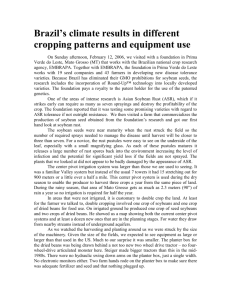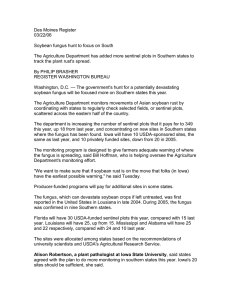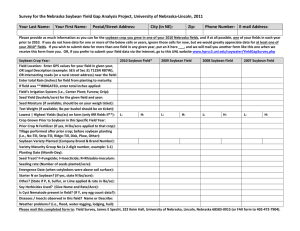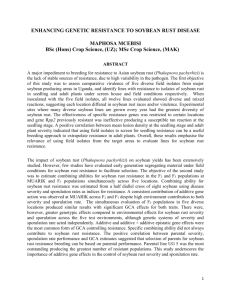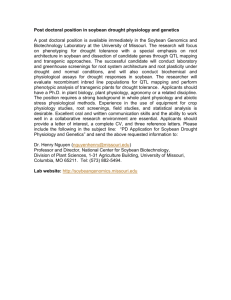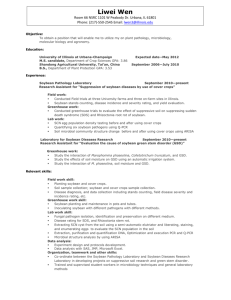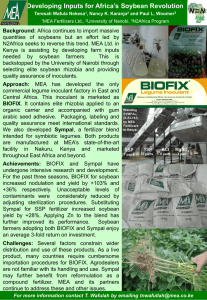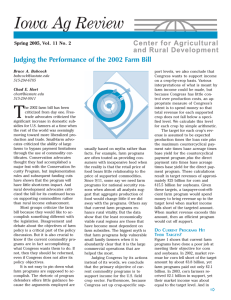Minutes of workshop and outputs - Proposal Project Management
advertisement
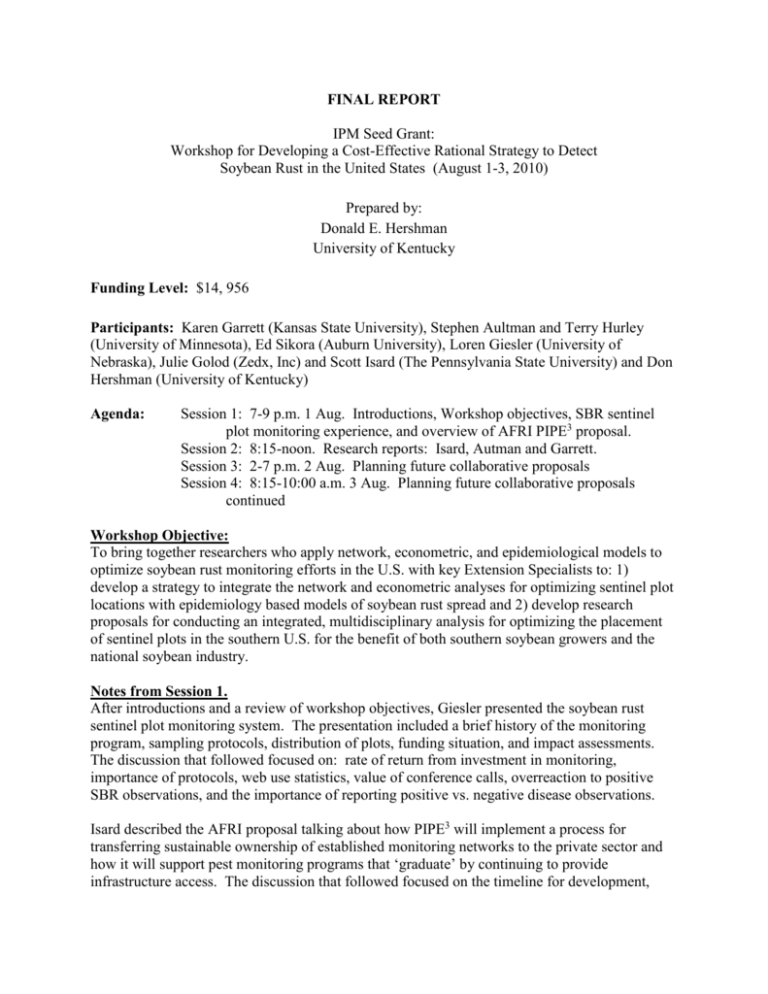
FINAL REPORT IPM Seed Grant: Workshop for Developing a Cost-Effective Rational Strategy to Detect Soybean Rust in the United States (August 1-3, 2010) Prepared by: Donald E. Hershman University of Kentucky Funding Level: $14, 956 Participants: Karen Garrett (Kansas State University), Stephen Aultman and Terry Hurley (University of Minnesota), Ed Sikora (Auburn University), Loren Giesler (University of Nebraska), Julie Golod (Zedx, Inc) and Scott Isard (The Pennsylvania State University) and Don Hershman (University of Kentucky) Agenda: Session 1: 7-9 p.m. 1 Aug. Introductions, Workshop objectives, SBR sentinel plot monitoring experience, and overview of AFRI PIPE3 proposal. Session 2: 8:15-noon. Research reports: Isard, Autman and Garrett. Session 3: 2-7 p.m. 2 Aug. Planning future collaborative proposals Session 4: 8:15-10:00 a.m. 3 Aug. Planning future collaborative proposals continued Workshop Objective: To bring together researchers who apply network, econometric, and epidemiological models to optimize soybean rust monitoring efforts in the U.S. with key Extension Specialists to: 1) develop a strategy to integrate the network and econometric analyses for optimizing sentinel plot locations with epidemiology based models of soybean rust spread and 2) develop research proposals for conducting an integrated, multidisciplinary analysis for optimizing the placement of sentinel plots in the southern U.S. for the benefit of both southern soybean growers and the national soybean industry. Notes from Session 1. After introductions and a review of workshop objectives, Giesler presented the soybean rust sentinel plot monitoring system. The presentation included a brief history of the monitoring program, sampling protocols, distribution of plots, funding situation, and impact assessments. The discussion that followed focused on: rate of return from investment in monitoring, importance of protocols, web use statistics, value of conference calls, overreaction to positive SBR observations, and the importance of reporting positive vs. negative disease observations. Isard described the AFRI proposal talking about how PIPE3 will implement a process for transferring sustainable ownership of established monitoring networks to the private sector and how it will support pest monitoring programs that ‘graduate’ by continuing to provide infrastructure access. The discussion that followed focused on the timeline for development, implementation, and stakeholder engagement for privatization and how the process to selfsustainability would free funds to support planning and monitoring for other high consequence pests. Notes from Session 2. Isard presented a scenario of soybean rust spread in the U.S. with 4 stages: 1) overwintering on kudzu along Gulf Coast; 2) local spread into commercial soybean fields; 3) Inoculum increase in commercial fields in South; and 4) aerial transport northward. He compared monthly maps of precipitation for years with SBR observations and discussed atmospheric pathways for spread from the Gulf Coast northward. Aultman and Hurley presented their dynamic model of farmer decision making framed in terms of the “two-armed bandit problem”. The model focused on the fungicide decisions farmers should make to minimize the expected cost of managing soybean rust as they learn more about the probability of soybean rust infections occurring each year. Garrett presented a network analysis methodology for predicting the spread of soybean rust using SBR sentinel plot observations. The methodology allows SBR spores to jump across multiple counties and incorporates wind speed and direction to bias spread in the downwind direction. Results indicate that removing information for randomly selected sentinel plots had only a modest effect on the predictive performance of the model when up to 50% of the plots were removed but removing more than that substantially decreased their models predictive ability. There was much discussion during, between and after each of the presentations. Notes from Sessions 3 and 4. A broad outline of a Research Proposal was developed by the group. A list of outputs/questions to be answered included: 1) optimize location of plots or scouting efforts; 2) geographic scales of sampling; 3) appropriate nature of scaling; 4) how do epidemic processes scale; 5) how will climate change affect the risk; 6) what is the optimal distribution of monitoring to achieve learning vs early warning; 7) how to detect climate changes impact on source area and strength, and pathways on an “ongoing basis” coupled with still providing timely and relevant management decisions; and 8) how growers respond to models vs. monitoring data? A list of research considerations that were discussed included: 1) scale of movement; 2) learning vs early warning; 3) pathways and connectedness; 4) in-season vs. across season time frames; 5) variability of sources; 6) disease triangle; 7) efficacy of management in response to monitoring signal /treatment window; 8) cross pest interactions/multiple-interactions; 9) accuracy of monitoring signal; 10) detection approaches and level of detection; and 11) scales of governance for network Potential outputs or end points of the proposal were also discussed: 1) Easy guide to management decisions (traffic light approach to communicate risk/approach); 2) validation of both in-season and pre-season model (different time scale and potentially resolution); 3) network models for forecasting disease spread; 4) network models for developing recommendations for targeted modeling; 5) established value for monitoring networks; 6) strategies for sustaining monitoring networks; and 7) novel conceptual framework for continental scale invasions and monitoring requirements. A consensus on two action items was achieved. It was also decided to expand the proposal to multiple cropping systems but limit pests for the purpose of research proposals to southern corn rust, leaf/stripe/stem rusts, and soybean rust. Outputs (based on, or significantly impacted by discussions during the funded workshop). Research Articles 1. Sutrave, S., Scoglio, C., Isard, S. A, Hutchinson, J. M. S., Garrett, K. A. (2012) Identifying Highly Connected Counties Compensates for Resource Limitations when Evaluating National Spread of an Invasive Pathogen. PLoS ONE 7(6): e37793. doi:10.1371/journal.pone.0037793 2. Garrett, K. A. 2012. Information networks for disease: commonalities in human management networks and within-host signaling networks. Eur. J. Plant Pathol. 133:75–88. DOI 10.1007/s10658-012-9963-y White Paper Hurley, T., K. Garrett, S. Aultman, E. Sikora, L. Giesler, J. Golod, S. Isard, and D. Hershman. 2010. Integrated Pest Management Crop Insurance for Air Borne Plant Pathogens. Successful Grants United Soybean Board (2011, 2012): Project Director: E. Sikora Project: Sentinel Plot Monitoring Program for Soybean Rust $330,550/year Unsuccessful Grant Agriculture and Food Research Initiative, Global Food Security: Program Delivery and Implementation of Wide-area Pest Monitoring (2010). Proposal Number: 2010-04836 Project Director: Scott A. Isard Proposal Title: Pest Information Platform for Extension, Education and Engagement Outcomes 1. Soybean rust has been successfully monitored using a greatly reduced, efficient soybean rust monitoring network. 2. Collaborative grants and a White Paper have been prepared. 3. Scientific literature regarding pest monitoring has been enhanced 4. New collaborative projects, such as the I-PIPE have been developed. Potential Impacts Soybean producers will potentially save millions of dollars annually as a result of our ability to continue to successfully monitor soybean rust using a scaled down, strategic monitoring network.
